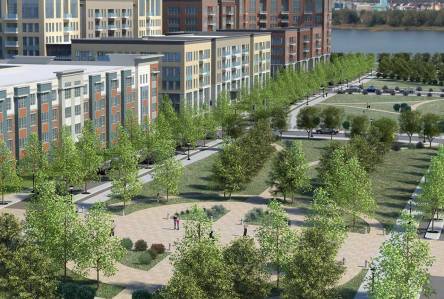Although a few states have begun relaxing visitation restrictions for assisted living facilities, the pandemic isn’t over yet. So senior living providers have continued to follow stringent protocols for protection. They’re doing all they can to keep residents healthy – and happy. Here’s another roundup of clients with uplifting stories to brighten your day: Festivities for Father’s Day Since families were unable to celebrate Father’s Day in person with their loved ones, staff at Merrill Gardens went above and beyond to make the day special for the dads in their communities. Employees in Monterey created little gift bags, provided lunch and hired a live jazz band to brighten things up. Staff at other communities, including Willow Glen and Madison, did their own versions of gift baskets as well. Check out Merrill Gardens’ blog post for the Father’s Day photos. Bringing families one step closer Over the past few months, many senior living communities have implemented their own version of window visits or visiting stations with barriers to protect residents. Aegis Living has taken the idea one step further by designing “outdoor living rooms,” complete with comfy chairs and decorations, to go with the plexiglass shields. “With each passing week of residents being physically separated from loved ones, we knew we had to find a better way,” said Kris Engskov, president of Aegis Living. “Design consulting and support from infectious disease experts and physicians helped us create these beautiful, new Outdoor Living Rooms to bring families together again – safely.” Horses with hats pay a visit While there’s no replacement for a family member dropping by to say hi, there’s no stopping a smile if horses in a clown hat and tiara walked up to your window. At Maple Wood Alzheimer’s Special Care Center, that’s...
Matrix Studies Up
Student Housing Insights
As colleges and universities announce varied plans to cope with coronavirus this fall, what will be the impact on student housing owners and operators? Some definitive answers were delivered in a July 15 webinar from Yardi Matrix, which also marked the launch of the Yardi Matrix Student data service. Market coverage includes over 2,000 universities and colleges nationwide, including the top 200 investment grade universities across all major collegiate conferences. Reports will also include data into shadow markets, defined as campus-proximate housing that often is rented by college students, though it may not be labeled as dedicated student housing. “The college experience is going to change, and has to change until there is a vaccine in place. This is a fall semester issue and probably into the middle of the spring semester,” Jeff Adler, vice president of Yardi Matrix, told the over 400 attendees at the outset of the online presentation. But that’s not all bad news for student housing, especially for providers with shadow market properties. Of the 200 universities Matrix researchers surveyed for the first study, many have announced plans to reduce dorm capacity levels to accommodate social distancing protocols. This means that more than 60 percent of students attending schools in the Yardi 200 will be living in such shadow market housing – and the total national percentage is higher. “Reduced dorm capacity requirements are a tailwind for off-campus housing,” Adler said. “Is student housing pandemic proof? I would say that it’s pandemic resistant. There is some choppiness expected, but I think overall the sector is going to hang in there.” Long term, the U.S. is expected to see an overall decline in its population of college-age adults, but with more Americans than ever earning four year degrees, attendee figures should...
Changemakers Series
Brenda Bacon, Brandywine
Will my loved one be happier and healthier in senior living or at home? It’s a question many families are asking themselves now during the pandemic. They’ve seen headlines about case numbers, but they also know they can’t provide the care and attention needed by themselves. “If COVID has taught us anything, it has taught us that we are health care, but it doesn’t mean that we have to be health care in the traditional sense of a hospital or a nursing home,” said Brenda Bacon, president and CEO of Brandywine Living. “We have to be able to convince the public or customers that their loved one will be safe and secure in addition to being happy.” A former board chairman for Argentum, Bacon has a lot of insight into the challenges and opportunities of senior living. She’s taken that unique experience to Brandywine, where she strives to make their communities the right mix of “health care and hospitality and fun.” Bacon has been recognized by Senior Housing News as a Changemaker for her contributions to the industry, and during her interview, she opened up on the difficulties posed by the coronavirus – as well as her strategies for keeping it at bay. Check out these excerpts to see how Brandywine is keeping its residents happy and healthy. What needs to be done to achieve that safety and security you’re thinking about? Any operational changes you’re implementing at Brandywine? On April 4th, we instituted a rule that says “one job only.” In the healthcare industry, employees traditionally work in two or three different healthcare institutions; they’ll work a shift at a skilled nursing and then they’ll go to an assisted living or the hospital, the doctor’s office. Nurses and care managers tend to have...
ICSC Webinar
CRE Adapts to Changing Times
In an ICSC webinar held in late June, Brian Sutherland, Yardi industry principal, moderated a panel discussion about how current economic and social challenges are forcing commercial operators to adapt to a changing market. They discussed the importance of AR management and evaluating tenant risk to accurately project future revenue and overcome the effects of the pandemic. Panel of experts: Gary Shaw – President, Arcadia Management Christine Mastandrea – EVP, Whitestone REIT Sutherland: On the Yardi side, in mid-March, we shifted 7,000 employees to work from home basically overnight. Can you talk about how you transitioned early in the response to the pandemic? Mastandrea: Within a very short timeframe we moved into a radical simplification mode. We expanded our meeting times to include more team members to be involved for consistency of communication all the way to the front-line ranks. We organized our team around four functions: client engagement, vendor management, stress testing and inner workforce. We moved our workforce offsite and we’ve gone from Zoom meeting to Zoom meeting. Client engagement is where we spent most of our time and we oriented about 80% of our workforce toward client engagement. We made sure we had our “four As”: alignment, assignment, accountability and then autonomy. We funneled all requests through one person in our legal department and made sure we had this process smoothed out over time. One major key was daily posting of cash collection and making sure everyone has an understanding of where we are and where we’re missing collection. We stopped mass emailing and instead got in contact on the phone with everyone we could, to understand who’s open and who isn’t, who is considered essential business and started discussing [Paycheck Protection Program] (PPP) funding. Shaw: We moved everything to the...
Building on Success
Impact Management Group
Impact Management Group, LLC has big plans for the future. The affordable housing property development and management company is set to expand its business strategy, and they have the experience, staff and investment in technology to help set themselves up for success. The new venture for Impact is into the fee management service industry. By this effort, Impact will assume property management and affordable housing program compliance responsibilities for properties owned by other parties, in exchange for a management fee. With the experience of managing approximately 1,400 affordable and market rate units across Wisconsin, Impact has a lot to offer clients. Their extensive industry knowledge not only boosts their credibility, but also serves as a valuable asset that potential clients can leverage to make their own affordable housing compliance programs more effective. Impact’s strategy to begin offering management services is to first focus on prospective clients with HUD 50059 units and properties, and then expand into management of portfolios composed of larger numbers of units, including Low Income Housing Tax Credit properties. Compliance mandates for these programs vary, and Impact’s experience will go a long way in helping its clients reduce the complexity of qualifying residents, calculating rents, managing vacant units, reporting to funding sources and more. A portion of Impact’s compliance expertise has been gained by support from RightSource. It’s expected that prospective clients will see how Impact works closely with RightSource and view the relationship as attractive in selecting a fee manager for their properties. “We couldn’t be where we are today without RightSource,” said Lisa Barkelar, vice president of Impact Management. RightSource, recently acquired by Yardi, offers compliance, consulting and training services, and specializes in serving clients of the affordable housing industry. All of RightSource’s software and services are now fully...
Relocations + Rent Drops
COVID-19 Prompts Migration
Already apparent in the U.S., COVID-19 has resulted in a migration from major cities and falling rents. As the housing industry braces itself against continued impacts from the virus, will both trends continue into the third quarter? Market analysts, real estate agents and renter surveys give us clues about what to expect. Are people really moving away from cities as a result of COVID-19? Yes. People are leaving cities to avoid COVID-19 risks and disturbances. Though it is a misconception that population density equates to higher risk, perception matters. The perceived increase in risk has made city residents feel less safe. That fear, coupled with other disruptions, motivates relocation for those who can afford it. Pew Research Center reports that 3% of U.S. adults moved due to the pandemic and about 6% had a member of their household relocate. Of those surveyed, 28% moved to reduce their risk of contracting the virus and 8% moved due to job loss. About 20% moved to be closer to family. Younger people make up a unique portion of those who relocated. Roughly 9% of adults ages 18-29 relocated due to the virus. This includes 23% of respondents who were university students forced to vacate their campuses. Even New York– the market trendsetter that has captured hearts for generations– is seeing mass movements to the nearby suburbs. Real estate agents Susan Horowitz and Monica Schwerberg explored the details in an interview with NPR. “We are seeing 20 offers on houses. We are seeing things going 30% over the asking price. It’s kind of insane,” Horowitz said. “It is a blood sport.” She adds, “Every last bit of it is COVID-related.” Schwerberg agrees, “In the month of April, where we typically would get maybe 75 inquiries in a month, we had over 400 inquiries.” People who once loved the city atmosphere are seeking locations with less population density, which is falsely assumed to correlate with increased infection risks. Additionally, many breadwinners are now working from home. Remote work opportunities have made commute times less of a factor in housing decisions. Since March 2020, about 10,000 New Yorkers filed for address changes to the state of Connecticut alone, reports Hearst Connecticut Media. Nationwide, U.S. Postal Service data indicates that southern Florida and southern California are popular relocation destinations. Who is moving during COVID-19? While some people are relocating due to job loss and financial difficulty, there is a correlation between job security, higher incomes and relocation. In short, households with higher incomes can afford to sell their current home (potentially at a loss) or terminate a lease early in favor of getting a new home in the suburbs. Higher income households are also more likely to have remote work. The ability to maintain income while working from anywhere permits the flexibility needed to relocate during the pandemic. Additionally, higher income households represent the demographic most likely to own a vacation home. About 13% of those who relocated moved into their second home or vacation home, reports the Pew survey. How does COVID-19 relocation impact the rental market? Yardi Matrix analyzed asset performance data from 107 major metropolitan areas between April and May 2020. During that time, multifamily rents declined by .4% nationwide. Overall, twice as many markets witnessed rents decline than rents rise. “Multifamily’s nearly decade long run of healthy performance increases came to an abrupt and unexpected end this year,” said Jeff Adler, vice president of Yardi Matrix. “Job losses have been particularly high among apartment renters, and simply collecting rents and maintaining occupancy is a new area of focus for owners and managers.” The report suggests that the pandemic’s influence on work conditions, public health metrics and social trends will continue to impact the housing marketing for the next several years. “If renters decide to eschew urban apartments for a more distanced standard of life in the suburbs or smaller cities, multifamily could...
Experts Assess
COVID-19 Energy Impacts
Along with tracking the momentous public health and economic implications of COVID-19, renewable energy advocates are keeping a close eye on how the pandemic is affecting the Earth’s environmental well-being. The International Energy Agency, which advocates for sustainable energy policies, reported that average global road transport activity fell by 50% of the 2019 level in the first quarter of 2020, while aviation activity declined 60%, spurring an unprecedented decline in world oil demand. The U.S. saw a 50% reduction in the use of jet fuel and 30% less gasoline consumed; meanwhile, natural gas use in commercial and residential buildings dropped by almost 20% from late March to early June of this year, according to a study of COVID-19’s effects on energy and the environment by researchers from the MIT Sloan School of Management, Yale University and Northwestern University. Reductions spark optimism “Overall, these reductions reflect a 15% total reduction in daily CO2 emissions, which is the largest annual percentage decline for the U.S. in recorded history,” says MIT Sloan professor Christopher Knittel, one of the researchers. The recent drop in consumption and emissions offers a glimpse of a cleaner future – if the effort is sustained after the crisis abates. In the wake of COVID-19, “it is essential that we build back better. We need to create a more resilient and sustainable clean energy system in order to reduce the risk of facing the catastrophic crises that climate change could bring,” says Jules Kortenhorst, CEO of the Rocky Mountain Institute, writing for the World Economic Forum. That means prioritizing structural changes that “make a real difference for the energy transition in the longer term” rather than jumping on “the bandwagon to push the green agenda in short-term relief packages,” say researchers from ETH Zurich’s...
Increase Tour ROI
6 steps from tour to lease
Sure, you’re booking more tours. But are you converting them? Here are six steps you can take every time a tour is booked that will help you get the lease. Customize your confirmation As soon as a prospective resident makes an appointment, you should send out a confirmation that includes all the necessary information (e.g. date, time, location, contact info). Ideally, your CRM system will automate that step for you, so your agents don’t have to manually respond 24/7. Each email should be customized to make the guest feel special. How do you customize an automated email? First, add their name to the email so it says something like, “Hi Jared, we’re so excited for your visit next Tuesday at 9:30 a.m.” Then, take it to the next level by asking a question. You can do something like: Upon your arrival we want to welcome you with a beverage of choice. Do you prefer x or y? We have a welcome gift for your tour. Would you prefer x or y? Both ideas work well for agent-led and self-guided tours, but even with virtual tours you can come up with creative ideas for gifts. You can easily email something like a Starbucks gift card or a coupon book for area businesses. Raise anticipation After you’ve confirmed the tour, raise anticipation to make sure your prospects don’t cancel or lease from a competitor. You can do this in several ways. One of the easiest methods is to take a quick video of yourself with your phone. In the video, you should greet them by name, show them something compelling about the unit or property and say that you can’t wait tour with them. Get other ideas that will help you raise anticipation in this episode...
Market Upsides
Maximizing potential as coronavirus continues
Even before the COVID-19 pandemic, multifamily market experts were talking about preparing for big economic changes. Now that rising unemployment rates, benefit delays and social distancing have created new challenges for real estate managers and renters alike, it’s time to re-think every aspect of your operations. Here’s some good news: there are real upsides to the downturn, including opportunities to move business online and improve communication to form stronger relationships with your customers. Read on for five key takeaways from Yardi’s operational strategies webinar that can help you right now and into the future. 1) Maximize marketing websites Apartment searches are on the rise and units are being rented sight unseen — and it’s all happening online. How can you keep up? Provide a virtual marketing and leasing experience from start to finish. Make sure your websites provide plenty of curb appeal for your listings, and include optimized photos, videos and 3-D floor plans along with virtual meeting and tour options. Offer live chat to answer questions from prospects and consider a chatbot when your agents are unavailable — a “contact us” email address or web form isn’t enough anymore. Use nudge marketing campaigns and page narratives to help prospects make timely rental decisions. And this is critical: bring your entire leasing process online from application to self-screening to lease execution with an electronic signature. Are you providing unit touring options? If you’re not offering self-guided tours yet, in this new world of contactless marketing it’s a great way to sign more leases. Even before the pandemic, self-guided tours were growing in popularity, and now they are a must to ensure social distancing and a contactless experience for your staff and customers. It’s important to plan for self-guided tours at the site level including the ability to verify prospect identities remotely before allowing access to your units. With COVID-19 concerns, you’ll also need a strategy for cleaning and sanitizing units after every visit. Once you figure it out, you’re likely to reap the benefits of agentless tours. 2) Consider strategy changes Take a good look at your marketing spend and identify which channels have provided you with long-term contracts and where your new opportunities are coming from. With a growing number of prospects willing to rent a unit sight unseen you need to take advantage of contactless opportunities. Ramp up your targeted marketing to those socially distant customers with a clear message about your easy online leasing process. Once you drive that motivated traffic to your website, those prospective renters can enjoy all the good stuff covered above including around-the-clock applications and leasing. 3) Send the right message Now is a great time to build stronger relationships with your residents. More than ever, communication with customers and within companies is critical. Be sure that your content, messaging and tone are not only aligned with your brand and our current reality but also resonate with what people really care about. We all need to feel safe and supported, and multifamily managers are in a unique position to create an inclusive and positive community for staff and residents. You can offer residents who are struggling financially payment plans and deferral options. If you haven’t accepted credit card payments for rent in the past, maybe now is the time to allow it to help keep your payment percentages high. There are also the day-to-day messages you need to push out to make sure your social distancing policies are followed when common areas and amenities are used. You will most likely see a big difference when it comes to renewing leases and keeping quality residents for the long term. 4) Reduce leasing risk With high unemployment and apartment fraud on the rise, you need to be sure you know exactly who you’re renting to. That doesn’t mean that prospects who are short on cash won’t be quality residents, so you’ll want to screen...
H.J. Russell & Co....
Preserving Communities
Imagine that you’ve enjoyed your home for decades: your kids’ growth charts are on a doorframe in the kitchen, you know your neighbors, and your favorite restaurants all know you by name and order. The neighborhood isn’t what it used to be, but it’s your home. Within a matter of years, a wave of new investments transforms your neighborhood. The cost of living increases and property taxes soar. You can no longer afford the home that you’ve nearly paid off, and you face eviction. That is the reality for many long-term residents of metro Atlanta neighborhoods. Neighborhood ascent, or gentrification, is the process of renovating communities that have experienced disinvestment. Through the process, crime rates drop, property values increase, infrastructure and services often improve. Gentrification, however, comes with grave disadvantages for existing residents including higher rents, higher property taxes, exclusion and discrimination. Yardi client H.J. Russell & Co. is an Atlanta-based firm that conducts construction, program management, and property management. It is aligned with sister real estate development firm Russell New Urban Development L.L.C. Together, they fight gentrification and nurture diverse neighborhoods through strategic projects and partnerships. Atlanta gentrification: an ongoing battle for “home” Atlanta is one of the nation’s largest cities for African Americans with 51.85% of the population identifying as Black or African American. It is also among the top 5 fastest gentrifying cities in the U.S. Several benefits come when investors support a brighter vision for a community. Unfortunately, that vision rarely implements practices that reduce out-migration and encourage long-term affordability. Longstanding residents are often excluded from the vision and priced-out of their homes. Neighborhood ascent does not necessitate segregation or displacement. With strategic planning and real estate firms such as H.J. Russell, neighborhoods can benefit from investment without ousting existing...
Changemakers Series
Loren Shook, Silverado
Due to COVID, some older adults and their families are hesitant on the idea of assisted living. But in many cases, and especially so for seniors with cognitive impairment, the level of care required for safe aging is only available in a community setting with skilled caregivers. “At this particular time of coronavirus, we’re working in a very fearful environment, and that’s where a trusting team benefits by the speed of trust,” said Loren Shook, founder and CEO of Silverado. “A lot of unknowns are being faced by people operating communities like ours and across the country.” Renowned for their standalone memory care communities, Silverado has pioneered research into programs that drive cognitive improvements for residents in early stages of dementia. The organization is often the top pick for referral partners, and the team is willing to take the most difficult cases. Silverado’s commitment to care, no matter the challenge, is helping them overcome COVID. And Shook’s willingness to try new things and continually adapt is why he’s been recognized as a Changemaker by Senior Housing News this year. Read on for excerpts from Shook’s interview with SHN where he discusses the perception challenges posed by COVID, interoperability opportunities with referral partners and the steps Silverado is taking to move forward. Do you see COVID-19 changing memory care specifically or senior living more broadly in more long-lasting ways? I think it’s really heightened the awareness of the buyer of services from us, as to asking, what are our systems for infection control and cleanliness? What are our capabilities for understanding changes in clinical condition for people? Then what do we do, if that’s the case? For some people, they’ll be asking, in a situation like COVID, if there is another pandemic or situation like...
Mixed-Income Housing
Pennrose + Omni Make History
As the demand for affordable housing continues to rise, local governments form unique partnerships to fill the need with efficiency and quality. Three Jersey City governmental agencies and two Yardi clients have joined forces to execute Bayfront Redevelopment Plan which includes the largest mixed-income housing development in the Tri-State region. A clean slate The significance of the Bayfront Redevelopment Plan begins with its history. The West Side of Jersey City has had it share of ups and downs. The diverse neighborhood is currently experiencing a renaissance as a wave of investors aim to highlight the beauty of the neighborhood’s eclectic nature. The new development will breathe life back into the Hackensack Riverfront, making it a thriving part of the West Side rather than a forgotten nook. Additionally, the new development will provide the neighborhood with the economic stability that accompanies mixed-income housing. Bayfront Redevelopment Plan includes the transformation of the former Honeywell Corporation building which the City acquired in 2016 for $100 million. The site, which will remain in control of the City, will boost the local stock of affordable housing from 5% to 35%. The plan is a leap forward for the neighborhood, and it is a formidable feat. Making the vision into a reality has required the collaboration of multiple entities. Mayor Steven M. Fulop, the Jersey City Redevelopment Agency (JCRA), and the Department of Housing, Economic Development and Commerce (HEDC) represent local governmental agencies. Yardi clients Pennrose, LLC, and Omni America, LLC created the joint venture Bayfront Development Partners, LLC, which will handle development and construction at the site alongside BRP Development Group. Omni: for the love of community Omni is a black-owned firm that acquires, rehabilitates, builds and manages quality affordable housing throughout the United States. The organization, which includes...
Student Housing
New product from Yardi Matrix
Already well known in the industry for its dependable, up-to-date and prescient market data, Yardi Matrix will take those skills to school as it begins reporting on the student housing sector. The new research area from Yardi Matrix comes at a particularly opportune time, as student housing owners and investors are navigating an uncertain environment caused by the COVID-19 pandemic. With many colleges and universities still making final decisions about what campus life and enrollment will look like in fall 2020, housing providers are anxious to see how this unprecedented situation will impact revenue streams and investment health. Quarterly Matrix reports focused on the student housing market will be available beginning this summer. Market coverage will include over 2,000 universities and colleges nationwide, including the top 200 investment grade universities across all major collegiate conferences. Reports will also include shadow markets, meaning campus-proximate housing that often is rented by college students, though it may not be categorized as traditional student housing. “We’re looking forward to offering the same comprehensive and future-thinking reporting that we do for the rest of the real estate industry to the student housing sector,” said Jeff Adler, vice president of Yardi Matrix. “We’ve done a deep dive into student housing fundamentals and look forward to sharing our insight with all who are interested.” To that end, the Yardi Matrix team will host a July 15 webinar focused entirely on the student housing market. Attendees can expect to gain insight on the short and long-term impact of COVID-19, best and worst-case scenarios, key indicators for operators and potential areas of opportunity. You can secure your spot in the online session by signing up here. Yardi Matrix offers the industry’s most comprehensive market intelligence tool for investment professionals, equity investors, lenders and property...
Long Term Impacts
New Yardi Matrix Report
With the U.S. economy in a recession, unemployment numbers sky high and COVID-19 cases surging in the south and west, multifamily owners and operators face challenging times ahead. And things may get worse before they get better, according to a new special report from Yardi Matrix. The report is based on a study of 107 major metros, with data reflecting April and May 2020 asset performance. Over that period, multifamily asking rents dropped .4% nationally, and twice as many markets saw rents decline as opposed to increase. Renters are looking for less expensive units, with the biggest impacts in the sector felt by Class A+ properties. Rents for “luxury lifestyle” properties dropped by -1.2% over the last two months, compared to a decline of .5% for “renter by necessity” properties. “Multifamily’s nearly decade long run of healthy performance increases came to an abrupt and unexpected end this year,” said Jeff Adler, vice president of Yardi Matrix. “Job losses have been particularly high among apartment renters, and simply collecting rents and maintaining occupancy is a new area of focus for owners and managers.” Multifamily had a long run of strong performance – asking rents grew by 26% nationally between January 2015 and 1Q20. But going forward, the future looks cloudy at best. “The shape of the recovery remains unclear. More importantly, the pandemic is spurring changes in working conditions and social trends that will impact housing demand for years to come,” states the report. What’s ahead will be determined by a complicated combination of economic factors, public health metrics and renters’ feelings about the future. If renters decide to eschew urban apartments for a more distanced standard of life in the suburbs or smaller cities, multifamily could be in for a prolonged pain period. Gain...
Yardi Think Tank
Build to Rent Post COVID-19
Yardi and Property Week recently invited experts from across the build-to-rent sector to take part in a digital debate on the key issues facing the market in the wake of the coronavirus pandemic. The consensus was that despite the challenges posed by the outbreak, there is also an opportunity for BTR to move forward and evolve Michela Hancock Managing director, Greystar Europe Justin Harley Regional director, Yardi Systems Hannah Marsh Co-founder & marketing director, HomeViews Sanjeev Patel Managing director, PPP Capital Kevin Watson Operations and commercial director, Platform Simon Creasey Contributing editor (features), Property Week (chair) Earlier this month, in the latest in the Yardi Think Tank series, Property Week contributing editor Simon Creasey chaired a discussion with key figures in the UK build-to-rent sector on how Covid-19 has affected BTR and the factors driving innovation for investors and residents. Also up for debate was how the pandemic might affect future BTR development. Simon Creasey: What impact has the Covid-19 lockdown had on your operations so far? Kevin Watson: The main impact has been on amenities spaces, which obviously have been closed now for a significant amount of time, and that’s clearly a key part of the value proposition of BTR. On the operations side, the thing that’s been really good to see is the transition to virtual and video viewings and other tools that enable engagement with residents. I think we’ve all been pleasantly surprised at how a lot of people both from the operator side and also from the resident’s side have taken to that. We still have some way to go to make those virtual viewings as interactive and as effective as a face-to-face viewing, but it’s been great to see that come through. Michela Hancock: We’re all kind of dealing...
Energy Benchmarking
Merrill Gardens + Yardi
When you invest in your energy strategy, the rewards are proportionate. Simply put, the upgrades can pay for themselves. You just have to get the ball rolling first. That was just one of the key takeaways from our recent webinar on energy efficiency with McKnight’s Senior Living. Randy Moss of Yardi led the discussion on ENERGY STAR benchmarking and best practices for providers, and he was joined by Christopher Wright from Merrill Gardens, who shared his company’s own experience with tracking energy usage and reducing spend. Merrill Gardens’ road to energy success Starting in 2016, Merrill Gardens was required to record and report their energy usage by the city of Seattle. And at first, everything was done manually. Staff were pulling data from paper bills and accounting systems to upload into ENERGY STAR for benchmarking. Eventually, the city’s utility provider enabled automated data sharing, which simplified the entire process. The state of California soon followed with regulatory requirements, and seeing the writing on the wall, Merrill Gardens began rolling out benchmarking at all of their communities nationwide. Like in Seattle, many utilities needed manual data entry at first, but nowadays, the majority allow automated data transfer. By late 2019, Merrill Gardens had a year’s worth of data, which gave them great visibility into their buildings’ usage compared to one another. “Based on those sorts of trends, we already had the ability to identify buildings to focus special attention on for CapEx and operation improvements,” said Wright. Unfortunately, the pandemic brought new hurdles, but that only sharpened their focus. “In early 2020, like everyone else, we discovered our resources were suddenly and unexpectedly limited, while at the same time, savings and operational efficiencies were even more important,” said Wright. “Partnering with Yardi over the last...
Building Economic Resilience...
The Value of Diverse Housing
Is it possible to shorten the fallout of an economic crisis? Researchers at the University of Maryland believe it’s possible. Preventative measures can mitigate the impact of economic downturns by creating neighborhoods that are naturally resilient to variances in economic performance. Diverse neighborhoods, researchers propose, can decrease the rate of foreclosures and sales before and after economic crises strike. What puts homogeneous neighborhoods at risk? After World War II, planners developed neighborhoods with a single income bracket in mind. Like their urban counterparts, these planned communities segregated individuals and families based on their earning power and, occasionally, place of employment. During difficult economic times, neighborhoods that lack diversity are prone to clusters of foreclosures and sales before and after the peak of the recessionary activity. Neighborhoods that relied heavily on one employer also suffered severe spikes in financial difficulties. The homogeneous nature of these neighborhoods left them vulnerable. If one company or industry suffered, the entire neighborhood suffered as well. Neighborhoods with high concentrations of bank-owned and for-sale homes take longer to recover from economic downturns. Residents that struggled with mortgages may have postponed home maintenance in an effort to conserve resources for mortgage payments. As a result, many foreclosed homes show signs of physical deterioration. Additional damages may occur during the eviction process. Neighborhoods with high concentrations of foreclosures and sales experience the devaluation of nearby homes. Additionally, as lender confidence decreases, so will investment in the area. To create neighborhoods that are more resilient in the face of economic trouble, University of Maryland researchers suggest that developers shift to mixed-income housing models. Uncovering the economic disadvantages of homogeneous neighborhoods The study began by creating a data set that logged zoning and foreclosures across 14 metropolitan statistical areas (MSA). Researchers selected MSAs from throughout the...
Warm Social Distance
Today’s Welcome Packages
Virtual and self-guided tours have helped numerous property managers fill a lease up during social distancing. When it comes to welcoming new residents, though, creativity and agile software make it possible to maintain space without seeming distant. Personalization is essential Personalization is a key element in helping new residents feel welcomed. These days, many of the best practices for personalizing welcome packages still apply. They simply require a bit of creativity to implement while keeping space, health, and customer satisfaction at the forefront of welcoming efforts. Leasing agents can assist welcoming committee members with helpful tips about the new residents. When your marketing and leasing platform integrates with your property management software, the notes that you put in prospects’ files easily transfer to resident files! Note pet ownership and areas of interest such as container gardening and DIY crafts. Your notes can inform the types of gifts included in each new resident’s welcome package. Remember: thoughtfulness makes a greater impression than price! Even when you can’t greet new residents face-to-face, the thoughtfulness and personalization of your welcome package can speak for you. Local treats delivered Since COVID-19 precautions required businesses to limit on-premises operations, delivery features have become a necessity. Many locally-owned small businesses that did not invest in delivery services have implemented them in recent months. The shift to delivery works in your favor. Include gift cards and discount vouchers in your welcome basket. Gifts from locally-owned shops and restaurants have an even stronger appeal. Every transaction is vital to small businesses. Your patronage demonstrates your efforts to support entrepreneurs in the community while giving residents a preview of the hyper-local treasures in the neighborhood. Use your online concierge platform as a delivery system for your welcome packages. Notify residents when the package...
New IPO Standards
Goldman Sachs’ Diversity Pledge
The first day of the Goldman Sachs diversity pledge has arrived. The investment bank announced that as of July 1, 2020, it will require diversity amongst the board members of new applicants in the United States and Europe. When announced in January, the investment bank could not have foreseen how poignant the pledge would become. All eyes on diversity Late spring and summer brought an onslaught of social issues to the forefront of American culture. As the nation attempted to establish a new normal amidst COVID-19 precautions, essential workers kept the economy and healthcare systems afloat. During these times, 1 in 3 women were considered essential workers. Also during this time, researchers revealed that the pandemic brought worsening economic and social inequalities for women. The necessary role of women in the workforce juxtaposed the inadequate measures to help them balance the demands of work and home. To add to the complexity, March marked the beginning of social unrest. A series of police-involved shootings sparked the first wave of protests highlighting discrimination against minorities within the justice system. The protests continued into June, joined by Pride Month events that highlight the struggles of the LGTBQ community in the workplace and healthcare system. Consumers and employees across the U.S. forced businesses and institutions to examine their inclusion practices or lack thereof. Goldman Sachs CEO David Solomon could not have foreseen any of this back in January. He could not have known that pandemic fallout and social justice demonstrations would place the bank at the forefront of the social equity revolution on Wall Street–but timing is everything, even when it’s unplanned. Bye bye “bro boards” Goldman Sachs now requires all American and European IPOs to have at least one “diverse” board member. Solomon emphasized that women are...
Reopening Multifamily Amenities
Tools and Tips for Property Managers
It has been about four months since U.S. multifamily communities restricted access to amenities like gyms and swimming pools. You’re likely eager to resume offering the stellar features that helped build your community brand. (Your residents are probably antsy, too!) As shelter-in-place restrictions lift, you may be unsure how to reopen those amenities with ongoing social distancing. It’s a valid concern, but we’re here to help. In this post, we’ll explore tips and tools for reopening your community amenities and public spaces. Before reopening your amenities Start by creating a reopening plan. The National Apartment Association (NAA) released recommended best practices for reopening amenities at multifamily properties. Along with those best practices, consider that a single reopening plan may not work for all properties, even those within a portfolio. It is important to customize a plan for each property so that directives align with the relevant guidelines issued by national and local health officials. You will also want to review your liability insurance policy and update it with pandemic provisions. Many insurance providers and legal institutions offer helpful customizable templates. Communicate these updates and obtain compliance signatures from property managers, vendors, staff and residents. Watch this webinar to learn how LumaCorp and Gables Residential navigated the reopening process. Preparing maintenance staff and vendors for reopening Your maintenance staff will be working double duty. You may even need to expand your maintenance team. Keep all team members on the same page with the latest cleaning schedules and updates using a mobile maintenance app. Yardi Advanced Maintenance provides the tools that you need to assign tasks, track and supervise your site’s schedule. Manage all preventive, routine and emergency maintenance within a single app. This tool will allow staff members to access revised cleaning schedules on the go and signoff on completed tasks without revisiting the office. Outside vendors will also need additional resources to stay up to date on revised supply and service schedules. Use a mobile vendor management system like VendorCafe to issue updates to existing vendors and onboard new vendors. You can also use the software to pay vendors, which will reduce traffic in the leasing office as well as lower printing, mailing and storage costs. Watch this video to learn how VendorCafe streamlines vendor communication and payments. Restoring full functionality to the leasing office If the community is like a body, then the leasing office is its brain. It’s the epicenter of services and sales that helps the community function. Due to its necessary function, the leasing office probably never completely closed, and that’s okay. The key now is to resume as much functionality as possible with fewer nonessential interactions. Use online payments and online maintenance requests to limit foot traffic in the leasing office. The RentCafe Resident app empowers residents to do both with a single login. The app has experienced 89% year-over-year adoption growth due to its simple user interface. You can also offer services to prospects while practicing social distancing at the leasing office. A survey of 3,000 apartment shoppers reveals that 83% of respondents would take a self-guided tour if available. Their reasons vary: nearly 60% of respondents wanted to observe social distancing. About 63% of renters want to tour model units at their own pace and 43% appreciate more flexible scheduling. Prospects can easily schedule self-guided tours online through your RentCafe marketing website. The app will automatically create a guest card and convenient customizable follow-ups. Join a webinar to learn more about the versatility and flexibility of RentCafe. You’ve got mail … and lots of packages Mailrooms have remained open at all properties, yet revisiting mailroom protocols can improve safety for occupants. Mailrooms are rarely spacious, which makes social distancing difficult for residents and mail personnel. Consider limiting the number of people who can enter the space at any given time. It may also be beneficial to close the mailroom for disinfecting after...




















